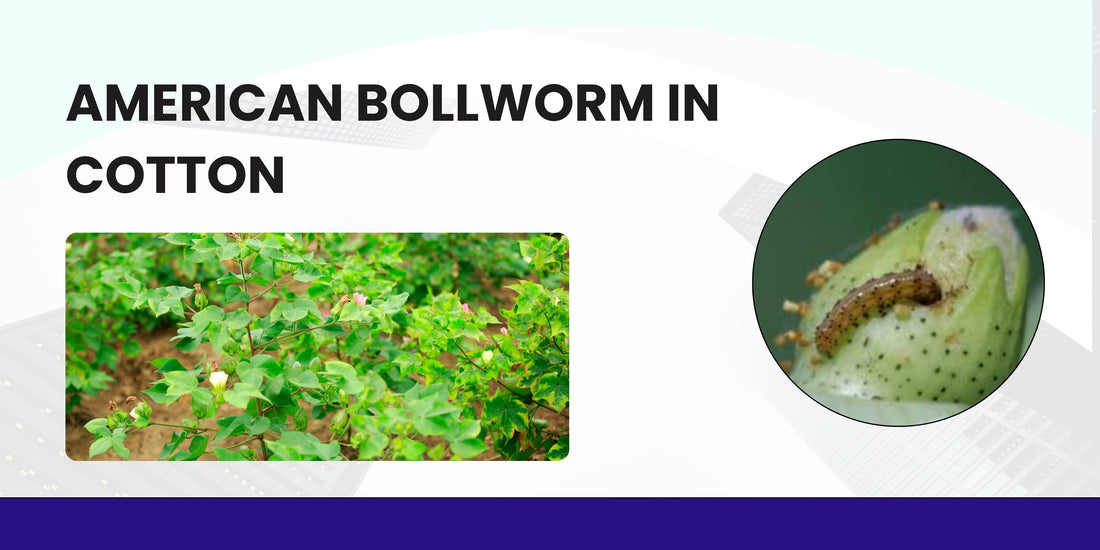
AMERICAN BOLLWORM IN COTTON
Telugu name: Shanaga pacha purugu
Scientific name: Helicoverpa armigera
Identification of the pest:
Eggs - Spherical in shape and creamy white in colour, present singly
Larva - Shows colour variation from greenish to brown.
It has dark brown grey lines on the body with lateral white lines and also has dark and pale bands.
Pupa - Brown in colour, occurs in soil, leaf, pod and crop debris
Adult
- Light pale brownish yellow stout moth.
- Forewings are olive green to pale brown in colour with a dark brown circular spot in the centre.
- Hind wings are pale smoky white with a broad blackish outer margin.
Lifecycle:
- Eggs are laid at night usually on the tender terminals of the top third of the plant. The female moth will lay 1,000 to 3,000 eggs and after 2 to 8 days, depending on temperature, the eggs hatch and the larvae commence feeding close by the oviposition site.
- The life cycle can thus be 25 to 35 days depending upon temperature, and six generations per year can be produced three of which could be on cotton.
Symptoms:
- Bolls showing regular, circular bore holes
- Larvae seen feeding on the boll by thrusting their heads alone inside and leaving the rest of the body outside
- Presence of granular faecal pellets outside the bore hole.
- A single larva can damage 30-40 bolls.
Favourable Conditions:
- Temperatures between 25°C and 35°C are ideal for the pest to grow and multiply.
- Humidity above 50% creates a suitable environment for their survival.
- Cotton plants with continuous flowering and fruiting provide food for the bollworm at different growth stages.
- Excess use of nitrogen fertilizers make the plants more attractive to pests.
- Dry conditions followed by rainfall encourage their development.
- Growing only cotton without crop rotation increases pest build-up in the field.
ETL: One egg or one larva per plant.
Management:
Monitoring:Pest monitoring through light traps, pheromone traps and in situ assessments by roving and fixed plot surveys has to be intensified at farm, village, block, regional and State levels. For management, an action threshold of one egg per plant or 1 larva/ plant may be adopted.
Cultural practices :
- Synchronised sowing of cotton preferably with short duration varieties in each cotton ecosystem.
- Avoid continuous cropping of cotton both during winter and summer seasons in the same area as well as ratooning.
- Avoid monocropping. Growing of less preferred crops like greengram, blackgram, soyabean, castor, sorghum etc., along with the cotton as intercrop or border crop or alternate crop to reduce the pest infestation.
- Removal and destruction of crop residues to avoid carry over of the pest to the next season, and avoiding extended period of crop growth by continuous irrigation.
- Optimising the use of nitrogenous fertilizers which will not favour mthe multiplication of the pest.
- Judicious water management for the crop to prevent excessive vegetative growth and larval harbourage.
Biological control :
-
Application of Nuclear Polyhedrosis Virus (NPV) at 3 x 10 12 POB /ha in evening hours at 7th and
12th week after sowing. - Conservation and augmentation of natural predators and parasitoids for effective control of the pest.
- Inundative release of egg parasitoid, Trichogramma spp., at 6.25 cc/ha at 15 days interval 3 times from 45 DAS
- Egg-larval parasitoid, Chelonus blackburnii and Predator Chrysoperla carnea at 1,00,000/ha at 6th, 13th and 14th week after sowing.
- ULV spray of NPV at 3 x 10 12 POB /ha with 10% cotton seed kernel extract, 10% crude sugar, 0.1% each of Tinopal and Teepol for effective control of Helicoverpa.
-
Note: Dicofol, methyl demeton, phosalone are comparatively safer to Chrysoperla larva
recording low egg mortality.
Chemical control :
- Discourage the indiscriminate use of insecticides, particularly synthetic pyrethroids.
- Use of proper insecticides which are comparatively safer to natural enemies such as endosulfan, phosalone, etc., at the correct dosage and alternating different groups of insecticides for each round of spray.
- Avoid combination of insecticides as tank mix.
- Adopt proper delivery system using spraying equipments like hand compression sprayer, knapsack sprayer and mist blower to ensure proper coverage with required quantity of spray fluid and avoid ULV applications or Akela spray applications.
- Proper mixing and preparation of spray fluid for each filling of spray fluid tank.
- For Effective control of bollworms use Biopesticide “LARVEX”.

FAQs:
1. How to identify American bollworm infestation in cotton crop?
Round holes in bolls and damage to flower buds. You'll also spot greenish-yellow larvae with dark stripes.
2. What is the most susceptible stage for the attack of American bollworm?
The bollworm attack is more during flowering and boll development stages, especially in warm, humid conditions.
3. What are the natural ways to control American bollworm?
Use neem oil sprays, install pheromone traps, or introduce natural predators like ladybugs and lacewings.
4. How to prevent American bollworm infestation next season?
Follow crop rotation, use pest-resistant cotton varieties, and destroy leftover crop residues.
5. What is the economic impact of bollworm on cotton yields?
Severe infestations can reduce yields by up to 50%, making timely control is important to prevent financial losses.
